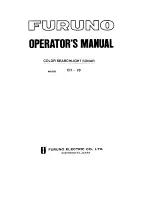
9
F
ISHING WITH THE
2100
How Your 2100 Works
The 2100 uses active SONAR, short for Sound Navigation and Ranging, to
locate and identify objects in the water. The transducer sends out short
bursts of ultrasonic sound waves into the water and then listens for echoes
to come back from objects and the bottom. The further away the object or
bottom is, the longer it takes the echo to return.
These ultrasonic waves “illuminate” the water, forming a beam that is
strongest in the direction that the transducer is pointed (see Figure 3).
Weaker side-lobes split off from the main beam and with enough gain can
be used for finding fish as well. You can calculate the approximate
diameter of the main beam on the bottom as the depth divided by six.
Figure 3.
SONAR beam (cross-section)
Reading the Graph
The bottom graph is created by drawing all of the echoes from a single
burst in a vertical column on the display, with the echoes from deepest
objects drawn lowest on the display. After all the echoes from the burst are
drawn, the graph is shifted to the left and the process is repeated (see
















